Deck 23: The Respiratory System
Question
Question
Question
Question
Question
Question
Question
Question
Question
Question
Question
Question
Question
Question
Question
Question
Question
Question
Question
Question
Question
Question
Question
Question
Question
Question
Question
Question
Question
Question
Question
Question
Question
Question
Question
Question
Question
Question
Question
Question
Question
Question
Question
Question
Question
Question
Question
Question
Question
Question
Question
Question
Question
Question
Question
Question
Question
Question
Question
Question
Question
Question
Question
Question
Question
Question
Question
Question
Question
Question
Question
Question
Question
Question
Question
Question
Question
Question
Question
Question

Unlock Deck
Sign up to unlock the cards in this deck!
Unlock Deck
Unlock Deck
1/87
Play
Full screen (f)
Deck 23: The Respiratory System
1
Each tertiary bronchus supplies a region of a lung called a/an _____.
A) bronchopulmonary segment
B) lobule
C) lobe
D) alveolar sac
A) bronchopulmonary segment
B) lobule
C) lobe
D) alveolar sac
A
2
The _____ is an internal ridge where the trachea divides into right and left primary bronchi.
A) carina
B) epiglottis
C) rimi vestibuli
D) cupula
A) carina
B) epiglottis
C) rimi vestibuli
D) cupula
A
3
Olfactory epithelium
A) lines the superior nasal conchae and adjacent nasal septum.
B) is the mucous membrane lining of the nasal cavity.
C) lines the superior, middle, and inferior nasal meatuses.
D) all of these choices
A) lines the superior nasal conchae and adjacent nasal septum.
B) is the mucous membrane lining of the nasal cavity.
C) lines the superior, middle, and inferior nasal meatuses.
D) all of these choices
A
4
Which of the following does NOT form part of the nasal septum?
A) cartilage
B) vomer
C) perpendicular plate of ethmoid
D) inferior nasal conchae
A) cartilage
B) vomer
C) perpendicular plate of ethmoid
D) inferior nasal conchae

Unlock Deck
Unlock for access to all 87 flashcards in this deck.
Unlock Deck
k this deck
5
Which of the following is a TRUE statement concerning the larynx?
A) The extrinsic muscles of the larynx connect the cartilages to each other.
B) During swallowing, the larynx rises, causing the epiglottis to form a lid over the opening into the larynx, closing it off.
C) The lining of the larynx inferior to the vocal folds is stratified squamous epithelium.
D) All of these choices are true.
A) The extrinsic muscles of the larynx connect the cartilages to each other.
B) During swallowing, the larynx rises, causing the epiglottis to form a lid over the opening into the larynx, closing it off.
C) The lining of the larynx inferior to the vocal folds is stratified squamous epithelium.
D) All of these choices are true.

Unlock Deck
Unlock for access to all 87 flashcards in this deck.
Unlock Deck
k this deck
6
The upper respiratory system includes all of the following EXCEPT:
A) pharynx.
B) nose.
C) trachea.
D) all of these choices
A) pharynx.
B) nose.
C) trachea.
D) all of these choices

Unlock Deck
Unlock for access to all 87 flashcards in this deck.
Unlock Deck
k this deck
7
The floor of the nasal cavity
A) is formed by the hard palate.
B) separates the internal nose from the external nose.
C) is formed entirely by the palatine processes of the maxillae.
D) is also called the nasal septum.
A) is formed by the hard palate.
B) separates the internal nose from the external nose.
C) is formed entirely by the palatine processes of the maxillae.
D) is also called the nasal septum.

Unlock Deck
Unlock for access to all 87 flashcards in this deck.
Unlock Deck
k this deck
8
The portions of the respiratory system that are capable of gas exchange include:
A) respiratory bronchioles.
B) alveolar ducts.
C) alveoli.
D) all of these choices
A) respiratory bronchioles.
B) alveolar ducts.
C) alveoli.
D) all of these choices

Unlock Deck
Unlock for access to all 87 flashcards in this deck.
Unlock Deck
k this deck
9
The _____ is/are the first portion(s) of the respiratory tract to enter lung tissue.
A) trachea
B) primary bronchi
C) secondary (lobar) bronchi
D) tertiary (segmental) bronchi
A) trachea
B) primary bronchi
C) secondary (lobar) bronchi
D) tertiary (segmental) bronchi

Unlock Deck
Unlock for access to all 87 flashcards in this deck.
Unlock Deck
k this deck
10
Which of the following is FALSE of the trachea?
A) The pseudostratified ciliated columnar epithelium of the mucosa contains goblet cells and basal cells.
B) It is a tubular passageway, posterior to the esophagus.
C) Its wall contains 16-20 C-shaped rings of hyaline cartilage.
D) The outer layer of the wall of the trachea, the adventitia, is a layer of areolar connective tissue that joins the trachea to surrounding tissues.
A) The pseudostratified ciliated columnar epithelium of the mucosa contains goblet cells and basal cells.
B) It is a tubular passageway, posterior to the esophagus.
C) Its wall contains 16-20 C-shaped rings of hyaline cartilage.
D) The outer layer of the wall of the trachea, the adventitia, is a layer of areolar connective tissue that joins the trachea to surrounding tissues.

Unlock Deck
Unlock for access to all 87 flashcards in this deck.
Unlock Deck
k this deck
11
Which of the following features of the lungs face(s) the heart? 1. costal surface
2) hilum
3) base
4) mediastinal (medial) surface
A) 1, 2
B) 3, 4
C) 2, 4
D) 1 only
2) hilum
3) base
4) mediastinal (medial) surface
A) 1, 2
B) 3, 4
C) 2, 4
D) 1 only

Unlock Deck
Unlock for access to all 87 flashcards in this deck.
Unlock Deck
k this deck
12
Which of the following do NOT contain cartilage? 1. tertiary (segmental) bronchi
2) alveolar ducts
3) respiratory bronchioles
4) terminal bronchioles
A) 1, 2, 3, 4
B) 2, 3, 4 only
C) 2, 3 only
D) 2, 4 only
2) alveolar ducts
3) respiratory bronchioles
4) terminal bronchioles
A) 1, 2, 3, 4
B) 2, 3, 4 only
C) 2, 3 only
D) 2, 4 only

Unlock Deck
Unlock for access to all 87 flashcards in this deck.
Unlock Deck
k this deck
13
As a molecule of oxygen passes from alveolar air into the blood it passes through the layers of the respiratory membrane in what order? 1. epithelial basement membrane
2) capillary basement membrane
3) alveolar epithelial wall
4) capillary endothelial wall
A) 3, 1, 2, 4
B) 4, 3, 2, 1
C) 1, 3, 2, 4
D) 3, 1, 4, 2
2) capillary basement membrane
3) alveolar epithelial wall
4) capillary endothelial wall
A) 3, 1, 2, 4
B) 4, 3, 2, 1
C) 1, 3, 2, 4
D) 3, 1, 4, 2

Unlock Deck
Unlock for access to all 87 flashcards in this deck.
Unlock Deck
k this deck
14
Functions of the nose include 1. olfactory (smell) reception
2) resonance of speech sounds
3) filtration of incoming air
4) warming of incoming air
5) moistening of incoming air
A) 1, 3, 4 only
B) 3, 4, 5 only
C) 1, 3, 4, 5 only
D) 1, 2, 3, 4, 5
2) resonance of speech sounds
3) filtration of incoming air
4) warming of incoming air
5) moistening of incoming air
A) 1, 3, 4 only
B) 3, 4, 5 only
C) 1, 3, 4, 5 only
D) 1, 2, 3, 4, 5

Unlock Deck
Unlock for access to all 87 flashcards in this deck.
Unlock Deck
k this deck
15
Compared to the left lung, the right lung
A) is broader.
B) is shorter.
C) has one more lobe.
D) all of these choices
A) is broader.
B) is shorter.
C) has one more lobe.
D) all of these choices

Unlock Deck
Unlock for access to all 87 flashcards in this deck.
Unlock Deck
k this deck
16
A bony landmark that identifies the point at which the trachea gives rise to primary bronchi is the _____.
A) suprasternal notch
B) level of first rib
C) superior border of the fifth thoracic vertebra
D) sternoclavicular joint
A) suprasternal notch
B) level of first rib
C) superior border of the fifth thoracic vertebra
D) sternoclavicular joint

Unlock Deck
Unlock for access to all 87 flashcards in this deck.
Unlock Deck
k this deck
17
The base of a lung is
A) the inferior surface.
B) concave.
C) just superior to the diaphragm.
D) all of these choices
A) the inferior surface.
B) concave.
C) just superior to the diaphragm.
D) all of these choices

Unlock Deck
Unlock for access to all 87 flashcards in this deck.
Unlock Deck
k this deck
18
The epiglottis
A) consists of a leaf-shaped piece of elastic cartilage.
B) is attached to the thyroid cartilage.
C) serves to route food and liquids into the esophagus.
D) all of these choices
A) consists of a leaf-shaped piece of elastic cartilage.
B) is attached to the thyroid cartilage.
C) serves to route food and liquids into the esophagus.
D) all of these choices

Unlock Deck
Unlock for access to all 87 flashcards in this deck.
Unlock Deck
k this deck
19
Which of the following are openings into the nasopharynx? 1. auditory (eustachian) tubes
2) fauces
3) internal nares
4) external nares
5) nasolacrimal ducts
A) 1, 2, 3
B) 1, 3 only
C) 4, 5
D) 2, 3 only
2) fauces
3) internal nares
4) external nares
5) nasolacrimal ducts
A) 1, 2, 3
B) 1, 3 only
C) 4, 5
D) 2, 3 only

Unlock Deck
Unlock for access to all 87 flashcards in this deck.
Unlock Deck
k this deck
20
The cardiac notch is a feature of the
A) right lung.
B) left lung.
C) heart.
D) diaphragm.
A) right lung.
B) left lung.
C) heart.
D) diaphragm.

Unlock Deck
Unlock for access to all 87 flashcards in this deck.
Unlock Deck
k this deck
21
The cardiac notch is a feature located on the medial aspect of the left lung.

Unlock Deck
Unlock for access to all 87 flashcards in this deck.
Unlock Deck
k this deck
22
Which of the following must occur for air to enter the lungs during inhalation (inspiration)?
A) The principal muscles of inhalation (inspiration) contract.
B) The volume of the lungs increase.
C) The pressure in the lungs falls below atmospheric pressure.
D) all of these choices.
A) The principal muscles of inhalation (inspiration) contract.
B) The volume of the lungs increase.
C) The pressure in the lungs falls below atmospheric pressure.
D) all of these choices.

Unlock Deck
Unlock for access to all 87 flashcards in this deck.
Unlock Deck
k this deck
23
The cricoid cartilage is an important landmark in determining the site for a tracheotomy.

Unlock Deck
Unlock for access to all 87 flashcards in this deck.
Unlock Deck
k this deck
24
The two types of alveolar epithelial cells are alveolar macrophages (dust cells) and Type II alveolar (septal) cells.

Unlock Deck
Unlock for access to all 87 flashcards in this deck.
Unlock Deck
k this deck
25
Which of the following is FALSE regarding the diaphragm?
A) It is skeletal muscle.
B) It receives innervation from the phrenic nerves.
C) In the relaxed state, the diaphragm moves inferiorly and flattens out.
D) When contracted, it increases the vertical diameter of the thoracic cavity.
A) It is skeletal muscle.
B) It receives innervation from the phrenic nerves.
C) In the relaxed state, the diaphragm moves inferiorly and flattens out.
D) When contracted, it increases the vertical diameter of the thoracic cavity.

Unlock Deck
Unlock for access to all 87 flashcards in this deck.
Unlock Deck
k this deck
26
The vocal folds (true vocal cords) of adult females are usually thinner and vibrate more rapidly than those of adult males.

Unlock Deck
Unlock for access to all 87 flashcards in this deck.
Unlock Deck
k this deck
27
The posterior (bony) portion of the nasal septum consists of the vomer and perpendicular plate of the ethmoid bone. The anterior portion is formed by the septal nasal cartilage.

Unlock Deck
Unlock for access to all 87 flashcards in this deck.
Unlock Deck
k this deck
28
Openings of the internal nose include the internal nares (choanae) and the ducts that connect to all paranasal sinuses.

Unlock Deck
Unlock for access to all 87 flashcards in this deck.
Unlock Deck
k this deck
29
The trachea is a tubular passageway for air, inferior to the larynx and anterior to the esophagus.

Unlock Deck
Unlock for access to all 87 flashcards in this deck.
Unlock Deck
k this deck
30
The left primary bronchus is more vertical, shorter, and wider than the right primary bronchus.

Unlock Deck
Unlock for access to all 87 flashcards in this deck.
Unlock Deck
k this deck
31
Pulmonary ventilation (breathing) involves the physical movement of air between the alveoli and atmospheric air.

Unlock Deck
Unlock for access to all 87 flashcards in this deck.
Unlock Deck
k this deck
32
The principal muscles of inhalation (inspiration) are the _____ and _____.
A) diaphragm, internal intercostals
B) internal intercostals, external intercostals
C) diaphragm, sternocleidomastoids
D) diaphragm, external intercostals
A) diaphragm, internal intercostals
B) internal intercostals, external intercostals
C) diaphragm, sternocleidomastoids
D) diaphragm, external intercostals

Unlock Deck
Unlock for access to all 87 flashcards in this deck.
Unlock Deck
k this deck
33
An examination of the wall of the airways in the bronchial tree from bronchi to alveoli would reveal that cartilage decreases in quantity and disappears, while the amount of smooth muscle increases.

Unlock Deck
Unlock for access to all 87 flashcards in this deck.
Unlock Deck
k this deck
34
The horizontal fissure is superior to the middle lobe of the right lung.

Unlock Deck
Unlock for access to all 87 flashcards in this deck.
Unlock Deck
k this deck
35
Normal exhalation (expiration) is due to
A) relaxation of inhalation (inspiratory) muscles.
B) the inward pull of surface tension due to the film of alveolar fluid.
C) recoil of elastic fibers in the lungs.
D) all of these choices.
A) relaxation of inhalation (inspiratory) muscles.
B) the inward pull of surface tension due to the film of alveolar fluid.
C) recoil of elastic fibers in the lungs.
D) all of these choices.

Unlock Deck
Unlock for access to all 87 flashcards in this deck.
Unlock Deck
k this deck
36
The pharyngeal tonsil (adenoid) and the auditory (eustachian) tubes are located in the oropharynx.

Unlock Deck
Unlock for access to all 87 flashcards in this deck.
Unlock Deck
k this deck
37
Which cranial bone(s) is/are most responsible for the skeletal framework of the nasal cavity?
A) sphenoid
B) nasal
C) ethmoid
D) inferior conchae
A) sphenoid
B) nasal
C) ethmoid
D) inferior conchae

Unlock Deck
Unlock for access to all 87 flashcards in this deck.
Unlock Deck
k this deck
38
For deep, forceful inhalation, accessory muscles of inhalation (inspiration) are: 1. external intercostals
2) internal intercostals
3) sternocleidomastoids
4) scalenes
5) pectoralis majors
6) pectoralis minors
A) 1, 3, 4, 5
B) 3, 4, 6
C) 1, 4, 5, 6
D) 2, 3, 5
2) internal intercostals
3) sternocleidomastoids
4) scalenes
5) pectoralis majors
6) pectoralis minors
A) 1, 3, 4, 5
B) 3, 4, 6
C) 1, 4, 5, 6
D) 2, 3, 5

Unlock Deck
Unlock for access to all 87 flashcards in this deck.
Unlock Deck
k this deck
39
Chemoreceptors are very sensitive to changes in CO2 concentration in the blood. Increased CO2 levels result in messages to the respiratory center to decrease the rate and depth of ventilation.
A) Both statements are true.
B) Both statements are false.
C) The first statement is true; the second is false.
D) The second statement is true; the first is false.
A) Both statements are true.
B) Both statements are false.
C) The first statement is true; the second is false.
D) The second statement is true; the first is false.

Unlock Deck
Unlock for access to all 87 flashcards in this deck.
Unlock Deck
k this deck
40
The true vocal cords are folds of mucous membrane called ventricular folds.

Unlock Deck
Unlock for access to all 87 flashcards in this deck.
Unlock Deck
k this deck
41
The anterior portion of the nasal cavity is called the choanae.

Unlock Deck
Unlock for access to all 87 flashcards in this deck.
Unlock Deck
k this deck
42
Type II alveolar (septal) cells secrete _____, which reduces the tendency of the alveoli to collapse.
A) mucus
B) surfactant
C) serous fluid
D) carbon dioxide
A) mucus
B) surfactant
C) serous fluid
D) carbon dioxide

Unlock Deck
Unlock for access to all 87 flashcards in this deck.
Unlock Deck
k this deck
43
Loss of elasticity of lungs and chest wall results in a decrease of as much as 50% of lung capacity by age 70.

Unlock Deck
Unlock for access to all 87 flashcards in this deck.
Unlock Deck
k this deck
44
Endoderm gives rise to the epithelium of the bronchi, while the connective tissue, cartilage, and smooth muscle are derived from mesoderm.

Unlock Deck
Unlock for access to all 87 flashcards in this deck.
Unlock Deck
k this deck
45
"Adam's apple"is the common name for the cricoid cartilage of the larynx.

Unlock Deck
Unlock for access to all 87 flashcards in this deck.
Unlock Deck
k this deck
46
Describe the lining tissue of the respiratory tract from the external nares (nostrils) to the beginning of the trachea. Relate the lining to the function of each area.

Unlock Deck
Unlock for access to all 87 flashcards in this deck.
Unlock Deck
k this deck
47
The paired laryngeal cartilages that, along with intrinsic pharyngeal muscles, move the vocal folds (true vocal cords) in speech production are the _____ cartilages.
A) cricoid
B) thyroid
C) arytenoid
D) epiglottic
A) cricoid
B) thyroid
C) arytenoid
D) epiglottic

Unlock Deck
Unlock for access to all 87 flashcards in this deck.
Unlock Deck
k this deck
48
Describe the location of each of the three regions of the pharynx.

Unlock Deck
Unlock for access to all 87 flashcards in this deck.
Unlock Deck
k this deck
49
The auditory (eustachian) tubes open into the _____ portion of the throat.
A) nasopharynx
B) oropharynx
C) laryngopharynx
D) hypopharynx
A) nasopharynx
B) oropharynx
C) laryngopharynx
D) hypopharynx

Unlock Deck
Unlock for access to all 87 flashcards in this deck.
Unlock Deck
k this deck
50
Name and locate the three areas of the respiratory center. Describe the function of each area.

Unlock Deck
Unlock for access to all 87 flashcards in this deck.
Unlock Deck
k this deck
51
The internal nose communicates posteriorly with the nasopharynx through the
A) vomer
B) internal nares (choanae)
C) conchae
D) external nares
A) vomer
B) internal nares (choanae)
C) conchae
D) external nares

Unlock Deck
Unlock for access to all 87 flashcards in this deck.
Unlock Deck
k this deck
52
The two portions of the respiratory center in the pons are the pneumotaxic and rhythmicity areas.

Unlock Deck
Unlock for access to all 87 flashcards in this deck.
Unlock Deck
k this deck
53
The laryngopharynx (hypopharynx), directs food from the oropharynx to the esophagus.

Unlock Deck
Unlock for access to all 87 flashcards in this deck.
Unlock Deck
k this deck
54
Sympathetic stimulation results in constriction of bronchioles.

Unlock Deck
Unlock for access to all 87 flashcards in this deck.
Unlock Deck
k this deck
55
List the cells found in, or associated with, the wall of an alveolus, stating the function of each one.

Unlock Deck
Unlock for access to all 87 flashcards in this deck.
Unlock Deck
k this deck
56
Describe the route traveled by a molecule of oxygen in inhaled (inspired) air from the time it enters the right external naris (nostril) until it reaches an alveolus in the apex of the left lung.

Unlock Deck
Unlock for access to all 87 flashcards in this deck.
Unlock Deck
k this deck
57
Cilia in the lower respiratory tract beat so as to move mucus and trapped dust in a superior direction.

Unlock Deck
Unlock for access to all 87 flashcards in this deck.
Unlock Deck
k this deck
58
Name and describe the nine pieces of cartilage of the larynx.

Unlock Deck
Unlock for access to all 87 flashcards in this deck.
Unlock Deck
k this deck
59
Describe the respiratory membrane in terms of thickness, tissue layers, and surface area.

Unlock Deck
Unlock for access to all 87 flashcards in this deck.
Unlock Deck
k this deck
60
Cilia in the upper respiratory tract beat so as to move mucus and trapped dust in a superior direction.

Unlock Deck
Unlock for access to all 87 flashcards in this deck.
Unlock Deck
k this deck
61
The epiglottis cartilage is attached to the vocal folds (true vocal cords).

Unlock Deck
Unlock for access to all 87 flashcards in this deck.
Unlock Deck
k this deck
62
What is the name of the area indicated? 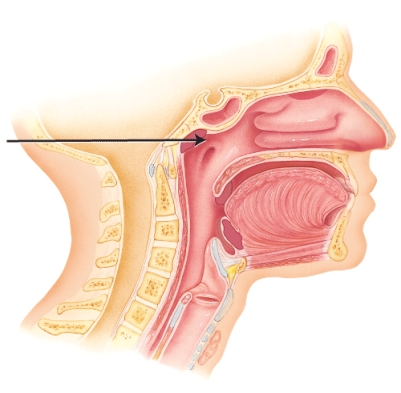
A) nasopharynx
B) sphenoidal sinus
C) oropharynx
D) frontal sinus

A) nasopharynx
B) sphenoidal sinus
C) oropharynx
D) frontal sinus

Unlock Deck
Unlock for access to all 87 flashcards in this deck.
Unlock Deck
k this deck
63
__________ branch off the aorta and bring oxygen rich blood to the lungs.
A) Coronary arteries
B) Pulmonary arteries
C) Bronchial arteries
D) Pulmonary veins
A) Coronary arteries
B) Pulmonary arteries
C) Bronchial arteries
D) Pulmonary veins

Unlock Deck
Unlock for access to all 87 flashcards in this deck.
Unlock Deck
k this deck
64
The cricoid is a movable flap of elastic cartilage associated with the larynx.

Unlock Deck
Unlock for access to all 87 flashcards in this deck.
Unlock Deck
k this deck
65
In this lateral view of the larynx, which cartilage is indicated? 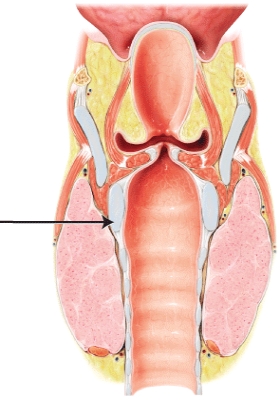
A) epiglottis
B) cricoid
C) thyroid
D) cuneiform

A) epiglottis
B) cricoid
C) thyroid
D) cuneiform

Unlock Deck
Unlock for access to all 87 flashcards in this deck.
Unlock Deck
k this deck
66
The _____ area in the _____ of the brain controls the basic rate of pulmonary ventilation.
A) pneumotaxic; pons
B) apneustic; midbrain
C) medullary rhythmicity; medulla oblongata
D) apneustic; thalamus
A) pneumotaxic; pons
B) apneustic; midbrain
C) medullary rhythmicity; medulla oblongata
D) apneustic; thalamus

Unlock Deck
Unlock for access to all 87 flashcards in this deck.
Unlock Deck
k this deck
67
The two processes of pulmonary ventilation (breathing) are internal (tissue) respiration and external (pulmonary) respiration.

Unlock Deck
Unlock for access to all 87 flashcards in this deck.
Unlock Deck
k this deck
68
Infants born before _____ weeks are severely at risk for respiratory distress syndrome (RDS) due to lack of sufficient surfactant in alveoli.
A) 26-28
B) 28-30
C) 32-34
D) 34-36
A) 26-28
B) 28-30
C) 32-34
D) 34-36

Unlock Deck
Unlock for access to all 87 flashcards in this deck.
Unlock Deck
k this deck
69
_____ neurons of the medullary rhythmicity area cause contraction of the diaphragm via signals sent through the _______ nerves.
A) Inspiratory; phrenic
B) Expiratory; phrenic
C) Inspiratory; intercostal
D) Expiratory; intercostal
A) Inspiratory; phrenic
B) Expiratory; phrenic
C) Inspiratory; intercostal
D) Expiratory; intercostal

Unlock Deck
Unlock for access to all 87 flashcards in this deck.
Unlock Deck
k this deck
70
The ___________________ receives signals from the _______________________ during forceful breathing.

Unlock Deck
Unlock for access to all 87 flashcards in this deck.
Unlock Deck
k this deck
71
Which of the following cartilages of the larynx is anchored to the trachea inferiorly?
A) cricoid
B) thyroid
C) epiglottis
D) arytenoid
A) cricoid
B) thyroid
C) epiglottis
D) arytenoid

Unlock Deck
Unlock for access to all 87 flashcards in this deck.
Unlock Deck
k this deck
72
The alveoli are lined with two types of epithelial cells: Type I alveolar cells (simple squamous epithelial cells) which are the main sites of gas exchange and Type II alveolar cells (septal cells) which secrete alveolar fluid.

Unlock Deck
Unlock for access to all 87 flashcards in this deck.
Unlock Deck
k this deck
73
Which of the following is INCORRECTLY matched?
A) pulmonary ventilation; breathing
B) external (pulmonary) respiration; gas exchange between air in alveoli and blood in pulmonary capillaries
C) internal (tissue) respiration; gas exchange between systemic capillary blood and tissue cells
D) external (pulmonary) respiration; the blood loses O2 and gains CO2
A) pulmonary ventilation; breathing
B) external (pulmonary) respiration; gas exchange between air in alveoli and blood in pulmonary capillaries
C) internal (tissue) respiration; gas exchange between systemic capillary blood and tissue cells
D) external (pulmonary) respiration; the blood loses O2 and gains CO2

Unlock Deck
Unlock for access to all 87 flashcards in this deck.
Unlock Deck
k this deck
74
The ______________ intercostal muscles and the _________________ contract during inhalation.

Unlock Deck
Unlock for access to all 87 flashcards in this deck.
Unlock Deck
k this deck
75
In this sagittal section, the arrow is pointing to which structure of the larynx? 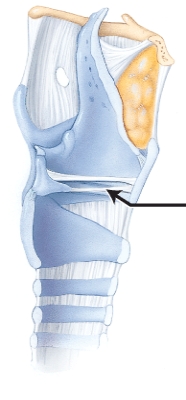
A) thyrohyoid membrane
B) tracheal cartilage
C) vocal fold (true vocal cord)
D) cuneiform cartilage

A) thyrohyoid membrane
B) tracheal cartilage
C) vocal fold (true vocal cord)
D) cuneiform cartilage

Unlock Deck
Unlock for access to all 87 flashcards in this deck.
Unlock Deck
k this deck
76
Which of the following cartilages forms the anterior wall of the larynx?
A) thyroid
B) arytenoid
C) epiglottis
D) corniculate
A) thyroid
B) arytenoid
C) epiglottis
D) corniculate

Unlock Deck
Unlock for access to all 87 flashcards in this deck.
Unlock Deck
k this deck
77
The trachea is lined with pseudostratified ciliated columnar epithelium with goblet cells.

Unlock Deck
Unlock for access to all 87 flashcards in this deck.
Unlock Deck
k this deck
78
Each lung may be subdivided into 10 small compartments called _____, and each of these is supplied by a branch of the bronchial tree called a _____.
A) lobules; secondary (lobar) bronchus
B) bronchopulmonary segments; tertiary (segmental) bronchus
C) bronchopulmonary segments; respiratory bronchus
D) lobules; tertiary (segmental) bronchus
A) lobules; secondary (lobar) bronchus
B) bronchopulmonary segments; tertiary (segmental) bronchus
C) bronchopulmonary segments; respiratory bronchus
D) lobules; tertiary (segmental) bronchus

Unlock Deck
Unlock for access to all 87 flashcards in this deck.
Unlock Deck
k this deck
79
In this lateral view of the right lung, the arrow is pointing to which structure? 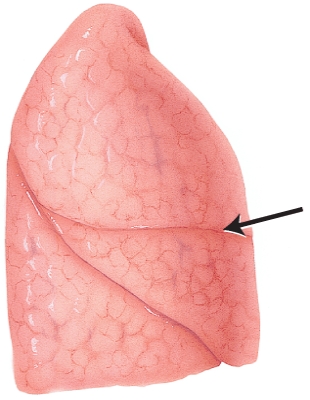
A) hilum
B) cardiac notch
C) apex
D) horizontal fissure

A) hilum
B) cardiac notch
C) apex
D) horizontal fissure

Unlock Deck
Unlock for access to all 87 flashcards in this deck.
Unlock Deck
k this deck
80
Which cartilages are indicated in the figure? 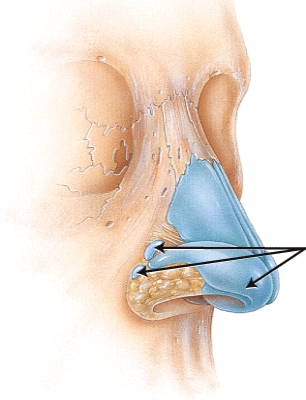
A) nasal
B) lateral
C) septal
D) alar

A) nasal
B) lateral
C) septal
D) alar

Unlock Deck
Unlock for access to all 87 flashcards in this deck.
Unlock Deck
k this deck



